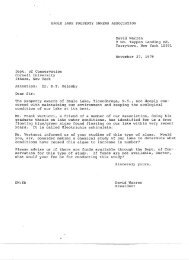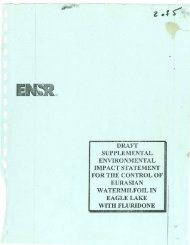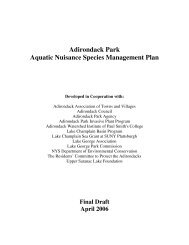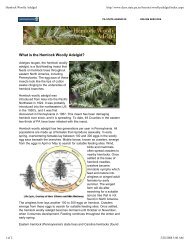Maine Field Guide to Invasive Aquatic Plants - Brant Lake Milfoil ...
Maine Field Guide to Invasive Aquatic Plants - Brant Lake Milfoil ...
Maine Field Guide to Invasive Aquatic Plants - Brant Lake Milfoil ...
Create successful ePaper yourself
Turn your PDF publications into a flip-book with our unique Google optimized e-Paper software.
U s i n g t h e F i e l d G u i d e<br />
B A C K G R O U N D<br />
The primary purpose of this guide is <strong>to</strong> help users recognize the eleven<br />
invasive aquatic plants on <strong>Maine</strong>’s invasive aquatic plant list, and <strong>to</strong><br />
distinguish these invaders from their more common native look alikes.<br />
One does not need <strong>to</strong> have previous knowledge of aquatic plants <strong>to</strong><br />
use this guide, or, for that matter, <strong>to</strong> successfully detect a suspicious<br />
aquatic plant. Indeed, most of the aquatic plant infestations known <strong>to</strong><br />
date in <strong>Maine</strong> have been detected by those with limited experience in<br />
plant identification.<br />
Though familiarity with the native plants is not a prerequisite for<br />
successfully screening waterbodies for invasive plants, it does provide<br />
some advantages. The more familiar one becomes with the plants that<br />
belong in a particular waterbody, the greater the likelihood that one<br />
will notice an “outsider” if and when it does appear. It is not unusual<br />
for one’s familiarity with <strong>Maine</strong>’s native aquatic plants <strong>to</strong> increase<br />
naturally during the survey process. This guide offers a starting point<br />
in this regard, providing useful information regarding some of the<br />
more common native plant species found in <strong>Maine</strong> waters.<br />
Generally, only common native plants that share one or more notable<br />
characteristics with one of the eleven listed invaders are included in<br />
this guide. Less common species have been included only in cases<br />
where the rarer species is a very close look alike <strong>to</strong> one of the listed<br />
invaders. Recommendations for additional native plant identification<br />
resources are provided in the Sources section.<br />
For those with some familiarity with aquatic plants, many of the more<br />
common plant species can be easily ruled out as being suspicious by<br />
observing them from a boat, using a viewing scope as needed.<br />
However, when one is starting out in unfamiliar terri<strong>to</strong>ry, it is a good<br />
idea <strong>to</strong> plan on collecting representative specimens from suspicious or<br />
unknown plants for later, more-detailed observation. For some plant<br />
species, accurate identification is virtually impossible (even for the<br />
seasoned expert) without collecting specimens for closer scrutiny.<br />
Tips For Using This <strong>Field</strong> <strong>Guide</strong><br />
1. Read through the Background section, especially the material on<br />
plant structure. If you have recently participated in <strong>Invasive</strong> Plant<br />
Patrol (or equivalent) training, a quick review of this section should be<br />
sufficient.<br />
2. Use the simplified key provided on page 12 <strong>to</strong> determine a possible<br />
identification for the plant in question. Turn <strong>to</strong> the page(s) indicated,<br />
and compare your specimen <strong>to</strong> the featured plant(s). Also check your<br />
specimen against all of the look alike plants listed for each featured<br />
species. Plant names shown in colored fonts, where used, indicate<br />
native or invasive status: red indicates an invasive plant species and<br />
green indicates native plant species.<br />
<br />
<strong>Maine</strong> Volunteer <strong>Lake</strong> Moni<strong>to</strong>ring Program
















